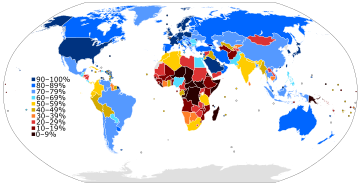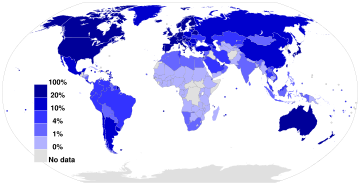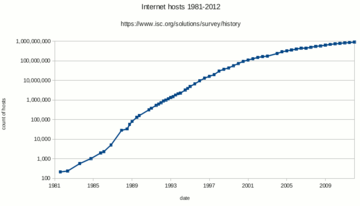History of Internet (Global digital divide)
Global digital divide
While developed countries with technological infrastructures were joining the Internet, developing countries began to experience a digital divide separating them from the Internet. On an essentially continental basis, they are building organizations for Internet resource administration and sharing operational experience, as more and more transmission facilities go into place.
Africa
At the beginning of the 1990s, African countries relied upon X.25 IPSS and 2400 baud modem UUCP links for international and internetwork computer communications.
In August 1995, InfoMail Uganda, Ltd., a privately held firm in Kampala now known as InfoCom, and NSN Network Services of Avon, Colorado, sold in 1997 and now known as Clear Channel Satellite, established Africa's first native TCP/IP high-speed satellite Internet services. The data connection was originally carried by a C-Band RSCC Russian satellite which connected InfoMail's Kampala offices directly to NSN's MAE-West point of presence using a private network from NSN's leased ground station in New Jersey. InfoCom's first satellite connection was just 64 kbit/s, serving a Sun host computer and twelve US Robotics dial-up modems.
In 1996, a USAID funded project, the Leland Initiative, started work on developing full Internet connectivity for the continent. Guinea, Mozambique, Madagascar and Rwanda gained satellite earth stations in 1997, followed by Côte d'Ivoire and Benin in 1998.
Africa is building an Internet infrastructure. AfriNIC, headquartered in Mauritius, manages IP address allocation for the continent. As do the other Internet regions, there is an operational forum, the Internet Community of Operational Networking Specialists.[42]
There are many programs to provide high-performance transmission plant, and the western and southern coasts have undersea optical cable. High-speed cables join North Africa and the Horn of Africa to intercontinental cable systems. Undersea cable development is slower for East Africa; the original joint effort between New Partnership for Africa's Development (NEPAD) and the East Africa Submarine System (Eassy) has broken off and may become two efforts.[43]
Asia and Oceania
The Asia Pacific Network Information Centre (APNIC), headquartered in Australia, manages IP address allocation for the continent. APNIC sponsors an operational forum, the Asia-Pacific Regional Internet Conference on Operational Technologies (APRICOT).[44]
In 1991, the People's Republic of China saw its first TCP/IP college network, Tsinghua University's TUNET. The PRC went on to make its first global Internet connection in 1994, between the Beijing Electro-Spectrometer Collaboration and Stanford University's Linear Accelerator Center. However, China went on to implement its own digital divide by implementing a country-wide content filter.[45]
Latin America
As with the other regions, the Latin American and Caribbean Internet Addresses Registry (LACNIC) manages the IP address space and other resources for its area. LACNIC, headquartered in Uruguay, operates DNS root, reverse DNS, and other key services.
Opening the network to commerce
The interest in commercial use of the Internet became a hotly debated topic. Although commercial use was forbidden, the exact definition of commercial use could be unclear and subjective. UUCPNet and the X.25 IPSS had no such restrictions, which would eventually see the official barring of UUCPNet use of ARPANET and NSFNETconnections. Some UUCP links still remained connecting to these networks however, as administrators cast a blind eye to their operation.
During the late 1980s, the first Internet service provider (ISP) companies were formed. Companies like PSINet,UUNET, Netcom, and Portal Software were formed to provide service to the regional research networks and provide alternate network access, UUCP-based email and Usenet News to the public. The first commercial dialup ISP in the United States was The World, which opened in 1989.[47]
In 1992, the U.S. Congress passed the Scientific and Advanced-Technology Act, 42 U.S.C. § 1862(g), which allowed NSF to support access by the research and education communities to computer networks which were not used exclusively for research and education purposes, thus permitting NSFNET to interconnect with commercial networks.[48][49] This caused controversy within the research and education community, who were concerned commercial use of the network might lead to an Internet that was less responsive to their needs, and within the community of commercial network providers, who felt that government subsidies were giving an unfair advantage to some organizations.[50]
By 1990, ARPANET had been overtaken and replaced by newer networking technologies and the project came to a close. New network service providers including PSINet, Alternet, CERFNet, ANS CO+RE, and many others were offering network access to commercial customers. NSFNET was no longer the de facto backbone and exchange point for Internet. The Commercial Internet eXchange (CIX), Metropolitan Area Exchanges (MAEs), and laterNetwork Access Points (NAPs) were becoming the primary interconnections between many networks. The final restrictions on carrying commercial traffic ended on April 30, 1995 when the National Science Foundation ended its sponsorship of the NSFNET Backbone Service and the service ended.[51][52] NSF provided initial support for the NAPs and interim support to help the regional research and education networks transition to commercial ISPs. NSF also sponsored the very high speed Backbone Network Service (vBNS) which continued to provide support for the supercomputing centers and research and education in the United States.




Comments
Post a Comment